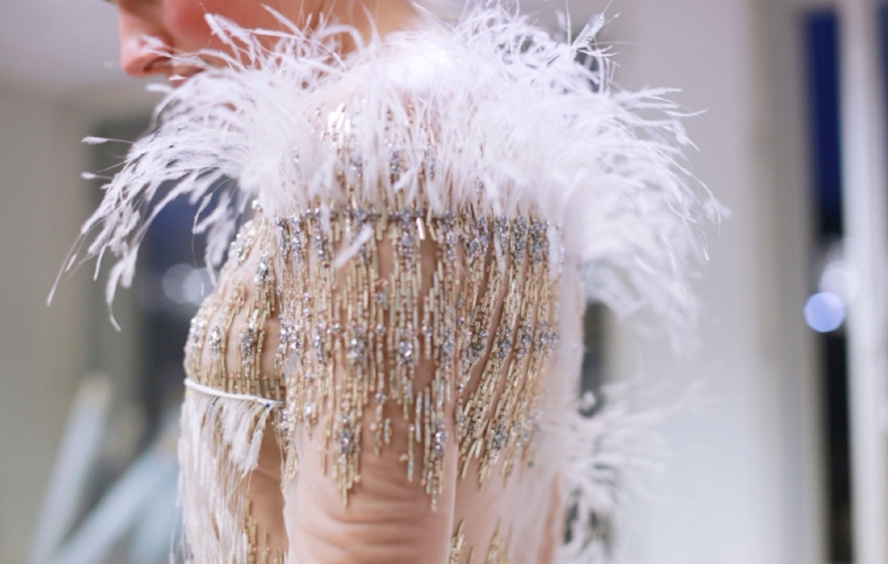Couture – much like many aspects of the fashion industry – is a game of smoke and mirrors. What Christina Binkley called a “hush-hush, mysterious, tradition-bound world,” writing for the Wall Street Journal in 2016, many couture clients tend to shy from revealing their seasonal purchases by way of interviews and brands are routinely vague as to the figures their dedicated fans shell out for these hand-crafted creations, which are made-to-order clothes for private clients.
What we do know is this: Fashion brands that have not been appointed by the Fédération française de la couture, the French body that regulates and oversees the industry of couture, are not legally permitted to refer to themselves as such. Despite this firm legal rule, and in light of mixed applications of the word “haute couture,” it is still very vague to most parties what the tenets of the Fédération française de la couture are exactly and what a house must be able to show in order to be considered for such an elite title.
As the Autumn/Winter 2019 couture shows kick off in Paris, here is a look at some of the cold-hard figures that have been associated with the notoriously evasive industry that is haute couture …
2 – The minimum number of fitting per design for a couture look that must take place with a client in accordance with the Fédération française de la couture’s guidelines.
6 – The number of employees, consisting of one première and five seamstresses, dedicated to creating each single couture garment at Versace.
15 – The minimum number of full-time staff members that a house must employ in order to be considered couture by the Fédération française de la couture.
15-20 – The number of weddings per year and private parties every month that Arab women typically attend, thereby creating a much bigger demand for couture than the occasional charity ball and high society party in Europe and in North America, per Reuters.
20 – The number of full-time technical workers that must be employed in an atelier (or couture workshop) in order for a house to be considered by the Fédération française de la couture as a couture house.
25 – The percentage of Maison Rabih Kayrouz’s couture consumers who are between ages 20 and 30/ An estimated 35 percent of the former Chanel and Dior designer’s couture clients who are “below age 40.”
30 – The percentage of Ralph & Russo’s annual revenue that comes from couture wedding attire (largely because of the cost of individual gowns rather than the number that are sold), per TFL.
45 – The percentage of Elie Saab’s total sales that are couture, with an increasing number of clients coming from the emergent countries, such as Turkey, Greece, Russia, Kazakhstan, Ukraine, etc.
50 – The number of individual designs — both day and evening garments — that houses were initially required to show during their bi-annual (January and July) couture shows in order to meet the Fédération française de la couture’s requirements. As noted by Alexander Fury for the New York Times, “In 1992, [this number] was cut in half. Then, in 2001, the goal posts shifted again, to introduce a qualitative assessment from the Fédération, in case any of the requirements were not satisfied.”
70 – The number of seamstresses employed in Valentino’s Rome atelier; this expands to 80 during the collection period, per Vogue.
100 – The number of seamstresses that worked on Chanel’s Spring/Summer 2015 couture collection.
135 – The number of hours it takes to create the average Dior couture dress.
1945 – The year that the Fédération française de la couture established its haute couture guidelines. They were subsequently updated in 1992.
4,000 – The estimated number of total couture buyers in the world. Over 200 of which – including socialite Marjorie Harvey, heiress/artist Daphne Guinness, socialite/philanthropist Lynn Wyatt, designer Ulyana Sergeenko (who was married to Russian insurance billionaire Danil Khachaturov), Lena Perminova (former model and wife of Russian billionaire Alexander Lebedev), Queen Rania of Jordan, Sheikha Mozah bint Nasser Al Missned, novelist Danielle Steel, Chinese heiress Wendy Yu, and socialite Mouna Ayoub Zulu – are regular buyers.
6,000 – The number of hours it took to create the final look in Ralph & Russo’s Spring/Summer 2016 couture show.
20,000 – The estimated number of total couture buyers at the industry’s peak in approximately 1950, following the introduction of Christian Dior’s 1947 New Look.
$50,000 – $300,000 – The range of cost for the average evening garment, according to the BBC.
$1,000,000 – The price that a Dior wedding dress can fetch, per Reuters.













